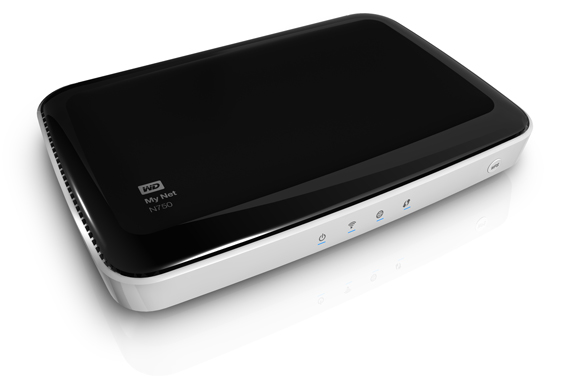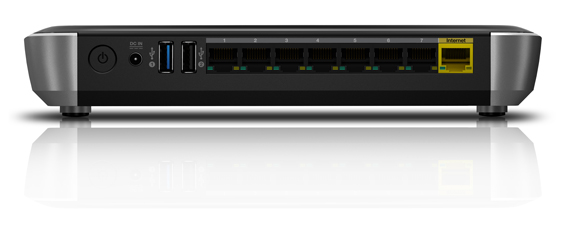Western Digital Enters Router Market with My Net Series
by Dustin Sklavos on June 14, 2012 8:00 AM EST- Posted in
- router
- Networking
- Western Digital
- 802.11n
We recently had the opportunity to take a meeting with Western Digital in San Francisco, California while a good chunk of the press were out in Taipei for Computex. It's difficult to get excited about new announcements from mechanical hard drive companies these days, especially with the way prices on the drives themselves haven't dipped much since the floods hit (with Western Digital being particularly guilty of maintaining those inflated prices), and with SSDs having become substantially cheaper over the past few months.
Which is what made our meeting with Western Digital so surprising. Western Digital is no stranger to networking and cloud-based products, but a full on line of routers? That's something else entirely. Western Digital is releasing four routers in their brand new My Net series, starting from the $79 My Net N600 all the way up to the exceedingly fancy $349 2TB My Net N900 Central, a combination router and NAS. Each router, top-to-bottom, is based on 802.11n and capable of running in both 2.4GHz and 5GHz bands.

The My Net N600 is the entry level router, featuring four 10/100 ethernet ports alongside a WAN port, a single USB 2.0 port for networking printers or storage, 300Mbps throughput on either band (or a cumulative 600Mbps throughput on both), and standard antennae instead of high range ones. At $79 it looks like a decent enough value for a dual-band router, but the lack of gigabit networking hurts a little bit. That changes when you move up to and past the N750. $119 gets you four gigabit ethernet ports, increased range, a second USB 2.0 port, and up to 450Mbps access on the 5GHz band.
From there, we have two versions of the My Net N900 router: one with built-in network attached storage (the My Net N900 Central), and one without. Both feature full 450Mbps throughput on either 2.4GHz or 5GHz bands (or a cumulative 900Mbps on both), high-range antennae, gigabit connectivity, and DLNA certification. The standard N900 features a whopping seven gigabit ethernet ports in addition to the WAN (the N900 Central offers only four) along with two USB 2.0 ports (one on the Central), and retails for $179. If you want internal storage, the 1TB model runs for $299 while the 2TB model runs for $349.

Beyond the basic speeds and feeds, Western Digital is leveraging their experience with cloud storage by adding a cloud backup service to each model in the line, easily accessible from anywhere you have internet access. Cloud access can be managed through a browser, but also through applications for Windows, Mac OS X, Android, and iOS. Western Digital also includes software to allow for automated backups to the networked storage and to the cloud, but unfortunately the automation only goes one way.
There's also Western Digital's secret sauce, their FasTrack Streaming technology. FasTrack is essentially traffic prioritization technology implemented in the core SoC that can be customized by the end user to allow for simultaneous gaming, downloading, and video streaming over the network with minimal interruptions or hiccups. Standard FasTrack supports up to 21 open queues and comes with six services pre-identified, and allows the end user to add and configure more services as needed. More interesting is the FasTrack Plus technology, available exclusively on the N900 routers (standard FasTrack is available only on the N600 and N750), which uses a dedicated chip for the QoS implementation. It supports unlimited open queues and actually dynamically analyzes sessions to intelligently route data.
Ganesh actually has an N900 in house for review as I write this post. We believe the routers are based on Qualcomm Atheros chipsets, and will be confirming it in our review.
At the $179.99 price point, it is the same as that of the 802.11ac routers already in the market. However, WD touts the QoS implementation (FasTrack / FasTrack Plus) and three extra GbE ports on the router as
the differentiation points. Depending on how much of an early adopter the consumer is, it might make sense to go with WD's implementations as 802.11ac capable equipment is not widespread yet. Also worth noting is that the N900 is actively cooled. Note also that despite having a blue USB port, Western Digital's routers do not support USB 3.0.
All of these routers, along with a basic My Net Switch featuring eight gigabit ethernet connections for $69, should be available today from retailers and online at www.wdstore.com. Ganesh's exhaustive review of the My Net N900 is forthcoming.










25 Comments
View All Comments
Candide08 - Friday, June 15, 2012 - link
"(Ono) offers up to 200 Mbps with no bandwidth caps.What's the matter with the North America!? Something has to be done. "
Corps do not want to re-tool. They keep the profit for Exec bonuses, rather than reinvesting in company products.
prophet001 - Monday, June 18, 2012 - link
I hope you see the phenomenal amount of irony in this statement.lol
cgeorgescu - Sunday, February 24, 2013 - link
Wow again... Something is definitely wrong with the net in States. Check this: http://www.rcs-rds.ro/internet-digi-net/fiberlinkThat's FTTB at 100mbps (no download limit) and a complimentary 3G USB stick (with bandwitdh capped if you go over 2GB/mo) for less than $6/mo (19.50LEI, it's a promotion, the regular price is $12/mo), available in all cities. And that's the most expensive offer you can find.
And that's in Romania, Eastern Europe (like 3rd world but, incidentally, the 2nd country in the world in terms of bandwidth, after South Korea, of course). Because of such cheap net access offers, here is very common to have free wifi, every cafeteria and bar has.
Again, something is wrong with the net in states, you have to do something. And, after seeing how a torrent comes with 11MBps, you'll never want to go back to ADSL.
Makaveli - Monday, June 18, 2012 - link
12 mb/s fast enough? not on my network.I'm currently seeing 30-70mb/s when transferring mkv's from main desktop after I rip them to my HTPC.
If you want sit and wait 40mins to transfter 4GB+ files then enjoy! i'd be halfway into watching my movie but the time your transfer is completed.
As fpr WAN sport speed in North America 100mbps is good enough with our lack of competition and government run monopolies for ISP's.
Visually I like the looks of this router very sleek but I won't be the person to go out and buy it will wait for reviews. As with most routers I find the firmware is key and it will make or break a good product.
name99 - Thursday, June 14, 2012 - link
I'd add:- ACTIVE cooling --- for a wireless router. Not a good sign.
- use of a blue USB port even though no USB3 --- that indicates a pretty shady mindset to me.
The GigE doesn't upset me as much because that's clearly a low-end issue, and because there really are different households with different needs. The usual household, which barely understands the concept of file sharing via AFP or SMB, and which thinks network is synonymous with internet, is probably just fine with 100Mbps.
notposting - Thursday, June 14, 2012 - link
Active cooling seems good to me...better to keep it cool and running than roasting and disconnecting during high load sessions. Shouldn't need to be loud either, just getting the air to cycle in and out of such a small space should be easy to do.name99 - Thursday, June 14, 2012 - link
My point is that a router+base station should not get hot enough to require active cooling.It's not a perfect comparison because it's two separate boxes, not one, but my (4 year old) D-Link Green 8-port GigHub runs cool, not even warm; while my (previous, not current gen) Apple Airport Base Station runs warm, not hot.
My complaint is not so much the fan as that I want to be sure that a device that is running 24/7 is not wasting a lot of power.
IMHO my DLINK hub is very good in this respect. The Apple Base Station is, frankly, pretty pathetic --- I have complained to Apple and hopefully one day they'll do better.
Measured against those, I fear this device is truly bad.
Maybe I'm unfair --- maybe it does a great job of using very little power while sleeping, and only needs the fan for the worst case scenario --- every single port + both wifi bands running at max. But I fear this is not the case.
Souka - Friday, June 15, 2012 - link
Active cooling is because of the router option which includes a internal HDD.Still, I would hope/think they'd be able to design an adequate heatsink but don't hodl your breath.
small heatsink + cheap fan = cheap solution.
big heatsink + intelligent thermal mangement + added weight + larger router design = higher cost and not as appealing to typical consumer.
JHutch - Thursday, June 14, 2012 - link
Just wondering if this would work as a poor man's file server (SMB based?) or if it is DLNA only. Neither the article, nor WD's page made it clear for me.Dustin Sklavos - Thursday, June 14, 2012 - link
Nearest I can tell, the USB storage should be fine as a poor man's file server. You can manually map network drives within Windows without having to install any applications (like D-Link requires on some of their models).